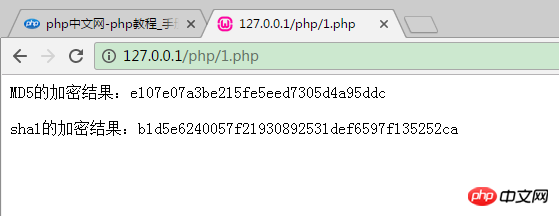
PHP encryption function—sha1() function encryption
First of all, let’s introduce what sha1 is?
The full name of sha is: Secure Hash Algorithm (Secure Hash Algorithm) is mainly applicable to the Digital Signature Algorithm DSA defined in the Digital Signature Standard (Digital Signature Standard DSS). For messages less than 2^64 bits in length, SHA1 produces a 160-bit message digest. When a message is received, this message digest can be used to verify the integrity of the data. During the transmission process, the data is likely to change, and different message digests will be generated at this time. The sha1() function provided by PHP uses the SHA algorithm!
In the two articles introduced before, "PHP encryption function—crypt() function encryption" and "PHP encryption function—md5() function encryption", I believe it Everyone has a certain understanding of encryption. In this chapter, we will continue to introduce the sha1() function algorithm, which is similar to the MD5() function.
The syntax format of the sha1() function is as follows:
string sha1 ( string $str [, bool $raw_output = false ] )
| Parameters | Description |
| string | Required. Specifies the string to be calculated. |
| raw | Optional. Specifies hexadecimal or binary output format: TRUE - raw 20-character binary format FALSE - default. 40-character hexadecimal number |
The function returns a 40-digit hexadecimal number. If the parameter raw_output is true, then a 20-digit binary number will be returned. , the default is raw_output is false.
Here we would like to emphasize that the 1 after
sha is the 1 in Arabic numerals (123456). It’s not the letter l (L). Many people will think of it as a letter, but it is an Arabic numeral. Everyone must pay attention here and don’t make a mistake!
The following is an example of the sha1() function. The specific code is as follows:
<?php
header("Content-Type:text/html; charset=utf-8");
$str = "中文网";
echo "字符串:".$str."<br>";
echo "TRUE - 原始 20 字符二进制格式:".sha1($str, TRUE)."<br>";
echo "FALSE - 40 字符十六进制数:".sha1($str)."<br>";
?>The output result is:

The following example is the result of outputting sha1() and testing it:
<?php
header("Content-Type:text/html; charset=utf-8");
$str = "中文网";
echo sha1($str);
if (sha1($str) == "b1d5e6240057f21930892531def6597f135252ca ")
{
echo "<br>I love 中文网!";
exit;
}
?>The output result is:
The following example is a comparison of MD5 and SHA encryption operations. The specific code is as follows:
<?php
header("Content-Type:text/html; charset=utf-8");
$str = "中文网";
echo "MD5的加密结果:".md5($str)."<br>";
echo "<br>";
echo "sha1的加密结果:".sha1($str)."<br>";
?>The output result is:

The main three data encryption functions in PHP, crypt(), md5() and sha1(), have been introduced. In the following article, we will introduce the PHP encryption library: two extension libraries of Mcrypt and Mhash!
【Related Recommendations】
1. Relevant topic recommendations: "PHP Encryption Function"
2. PHP encryption function—crypt() function encryption usage example
3.PHP encryption function—md5() function encryption usage example
4 .PHP encryption technology video tutorial
The above is the detailed content of PHP encryption function—Instance usage of sha1() function encryption. For more information, please follow other related articles on the PHP Chinese website!




